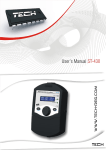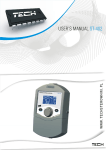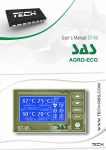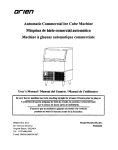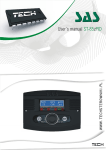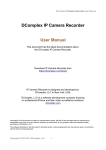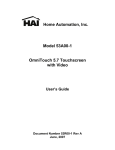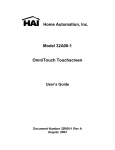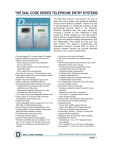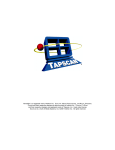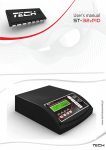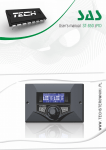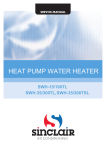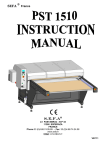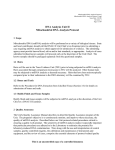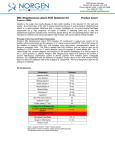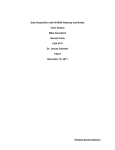Download ST-431 - Kotly.com.pl
Transcript
tech -1- ST-431 – user manual Declaration of Conformity No. 42/2010 Hereby, we declare under sole responsibility that the ST-431 230V 50Hz thermoregulator manufactured by TECH, ul. St. Batorego 14, 34-120 Andrychów, is compliant with the Regulation by the Ministry of Economy. (Journal of Laws Dz.U. 155 Item 1089) of July 21, 2007 implementing provisions of the Low Voltage Directive (LVD) 2006/95/EC of January 16, 2007. The ST-431 controller has been tested for electromagnetic compatibility (EMC) with optimal loads applied. For compliance assessment, harmonized standards were used: PN-EN 60730-2-9:2006. Paweł Jura, Janusz Master -2- tech ATTENTION! High voltage! Make sure the regulator is disconnected from the mains before working on the power supply (cable connections, device installation, etc.)! All connection works must only be carried out by qualified electricians. Before activating the controller, measure the motor resetting efficiency and inspect wire insulation. -3- ST-431 – user manual -4- tech I. Application Thermoregulator type ST-431 is intended for operation of three- or four-way mixing valve with a possibility of connecting additional valve pump. Optionally, the controller may cooperate with two modules ST61, which enables to control altogether three mixing valves. The controller is equipped with weather control function,1-week program and may cooperate with the room regulator. An additional advantage of the device is the protection of return temperature, which fulfils the function of protection against boiling of the water in the short boiler circulation or against too low temperature of the water returning to the water boiler. II. Principle of operation Description of the control panel PRESET TEMPERATURE VELVE TEMPERATURE STANDBY MODE (STANDBY) OPENING PERCENTAGE EXIT PULSE GENERATOR The principle of operation of the controller to valve servomotor is based on mixing feed circulating warm water with water returning from the heating circulation, in order to set the desired temperature and maintain it all the time at the same level. A pump connected to each valve is supposed to help to distribute water in the system that is not based on gravitation circulation. The pump should be installed behind the mixing valve, while the temperature sensor should be placed behind the valve and the pump, for the purpose of the most accurate control of the temperature at the valve outlet. ATTENTION: if the valve controller operates simultaneously in a common -5- ST-431 – user manual circulation with the controller of the boiler, the pump should be connected from the boiler controller (pump outlet from regulator TS-431 will remain disconnected). The control takes place with the use of pulse generator knob. Entering the menu and confirming settings proceed by pressing the knob. When turning it, a user operates in MENU functions. To go to the higher level menu, use exit button. Any settings may be changed in a similar manner. II.a) Main page During normal regulator operation , graphic display shows the homepage, on which the following are displayed: HOUR WORKING BOILER PROTECTION Valve type: - CH - Floor PUMP OPERATION ACTIVE MODULES ACTIVE VALVE By turning the pulse generator, the preset temperature may be changed easily. After pressing pulse generator knob, the user moves to the main menu. To change appearance of the homepage to the view of temperature sensors or one of the additional valves (if active), press EXIT. Then, after choosing another screen, homepage view is changed. -6- tech III. Main menu III.a) Set temperature With this option, the requested temperature the valve is supposed to maintain, is set. In the course of correct operation, the temperature of water behind the valve will be approaching the preset valve temperature. III.b) Activated This option is used to activate the mixing valve. When the valve is deactivated, then the pump does not operate, either. In spite of the fact that valve is deactivated, calibration always takes place after switching the controller to the network. It prevents remaining of the valve in a position dangerous (see chapter III.d) for the circulation. III.c) Screen view Using this function, appearance of the homepage may be changed between the views of the basic valve, the view of the sensors' temperatures or the view of parameters of one of additional valves (only when the valves are active). After selecting the view sensors' temperatures, on the homepage the following temperatures are visible: of the valve (set and current), return temperature and external temperature. On the contrary, selection of the view valve 1 or valve 2 results in displaying on the homepage parameters of the closed valve: preset and current temperatures, external temperature and return temperature, and the percentage of opening of the chosen valve. III.d) Valve calibration -7- ST-431 – user manual Using this function, initial setting of the valve is controlled. During calibration, the valve is set to a safe position, that is, for CO valve, to a fully open position, while for floor valve - to a closed position. During calibration, at the bottom of the screen, the following symbol is displayed: . III.e) Manual operation After selecting the option manual operation, the user has the possibility of manually opening/closing the valve (and additional valves, if active) and switching on or off the pump for the purpose of inspection of the correct operation of the device. III.f) Installer menu Functions included in installer menu will be described in detail in subsequent chapters of this manual. III.g) Servicing menu Functions included in the servicing menu are protected by code and are not available for the user. III.h) Language selection A user can select the language version of the controller. -8- tech III.i) Factory settings The regulator is pre-configured for operation. However, it should be adjusted for own needs. Return to the factory settings is possible at any moment. By activating the factory settings option, all own adjustments are replaced by the settings saved by the manufacturer. From that moment, the own parameters may be set once again. III.j) About the program After activating this option, the display shows the boiler manufacturer's logo along with software version of the regulator. IV. Installer menu IV.a) Summer mode In this mode the regulator closes CO valve, so as not to heat house unnecessarily, but in the case of achieving, too high temperature of the boiler (requires activation of the return protection!) the valve will be open in emergency mode. This mode is not active in the case of controlling floor valve. IV.b) Pump anti-stop After activating this option, pump valve will activate every 10 days for 2 minutes. It prevents too long water stagnation in the assembly beyond the heating season. -9- ST-431 – user manual IV.c) Boiler sensor In this submenu, the user determines basic boiler protection parameters and pump activation. IV.c.1) Return protection This function permits setting the boiler protection against too cool water returning from the main circulation, which could cause low-temperature boiler corrosion. The return protection operates in the way that when the temperature is too low, valve is closed, until the short circulation of the boiler reaches the appropriate temperature. After activating it, user presets the minimum acceptable return temperature. IV.c.2) Boiler protection The protection against too high return temperature serves to prevent the hazardous growth in boiler temperature. The user sets the maximum acceptable return temperature. In the case of the hazardous growth in temperature, the valve begins to open to house installation in order to cool the boiler down. This function is activated permanently (the possibility of deactivation only in the service menu). IV.c.3) Pump activation This option allows to select the working mode of a pump. A pump shall be activated: always (pump operates all the time, regardless of temperatures), never (pump is permanently deactivated and the regulator controls only operation of the valve, above the threshold (the pump is activated above the set activation temperature ). In the case when the circulation pump is connected with the boiler controller, it is recommended to - 10 - tech deactivate its operation in the driver of valve ST-431. IV.d) Temperature control This parameter determines water temperature measurement (control) frequency behind the CH or HWT installation valve. If the sensor indicates a change in temperature (deviation from the set value), then the electric valve will open or close by the set stroke, in order to return to the preset temperature. IV.e) Reduction in room control This function is active only in the case when the valve cooperates with the room regulator. In this setting, one should preset the temperature by which the valve decreases its preset temperature, at the moment of achieving the preset temperature at the room regulator (room heat-up). NOTE: If in function Room regulator (see IV.e) option Closing is set, then function Reduction in room control is inactive. IV.f) Room regulator This option is used to set the manner in which the valve will react to a signal about room heat-up (from the room regulator). If option Reduction in room control is selected, then the valve, after a signal about heating-up (from the regulator room) will lower temperature behind the valve – according to the set parameter Reduction in room control (see IV.e). In the event when option Closing is selected, the valve will react to the signal about heat-up room with maximum closing (see item IV.m) and deactivation of the pump. IV.g) Proportionality coefficient - 11 - ST-431 – user manual Proportionality coefficient is used for defining valve stroke. The closer the preset temperature, the smaller the stroke. If this coefficient is high, the valve will faster achieve the opening close to the relevant. However, the opening will not be accurate. Single opening percentage is calculated on the basis of a formula: (SET_TEMP - SENSOR_TEMP) * (PROP_COEFF /10) IV.h) Maximum floor temperature This is the maximum temperature, which does not damage floor installation. Setting this temperature is used, when valve type is set as the floor type. After reaching this temperature, a complete valve closure takes place, and a user is informed about that by means of a relevant alarm. If the maximum floor temperature is reached, the boiler protection function is deactivated. In this case, the floor installation protection will have a higher priority. IV.i) Opening direction If after connection of the valve to the controller it turns out that it was to be connected the other way round, then the power supply cables do not have to be switched, it is enough change the opening direction in this parameter. LEFT * RIGHT * IV.j) Operation modes In this function, user selects the working mode between: STANDARD - the controller maintains the preset temperature at the valve exit level. ROOM CONTROL - the controller maintains the temperature of the valve till the moment in which room the regulator gives the signal about heating-up of the room (contact opening). Then the preset temperature will be reduced by the temperature value set for parameter REDUCTION IN ROOM CONTROL - 12 - tech (see chapter: IV.e). The reduced preset temperature will not be displayed on the main screen of the controller. The information that the room regulator indicated that the room is heated up is signalled by room regulator symbol<p>(continuous display, not pulsating). WEATHER CONTROL - the preset valve temperature depends on the temperature outside. It is calculated on the basis of parameters saved in functions Weather-based control (see chapter IV.s). ROOM AND WEATHER CONTROL – in this mode, when the room regulator does not reach the set temperature, valve operates just as in weather control. At the time when the room is heated up to the set temperature of the regulator , the valve starts to operate in mode room control (at achieved room control). While this mode is active, on the display the symbols of weather control and room control pulsate alternately. After reaching the temperature preset by the controller, the symbol<p>(room regulator heated up) will be displayed permanently. WEEKLY CONTROL - the preset valve temperature depends on the deviations defined for particular weekdays in Chapter Weekly control (see item IV.t). In this mode room control or weather control are disabled. The information on active weekly control is pulsating on the main screen value of the current temperature deviation (at the place of text "preset"). IV.k) Opening time Parameter specifying the time needed for the servomotor valve to open from 0% to 100% position. This time should be selected according to the owned valve servomotor (stated on the rating plate). IV.l) Unit step This is a maximum single stroke (opening or closing) that the valve may make during one temperature sampling. If it is near the preset temperature, the stroke calculated on the basis of WSP PROPORCJON parameter position. The smaller the single stroke, the more precisely the set temperature can be achieved. However, the preset temperature is being fixed for a longer time. - 13 - ST-431 – user manual IV.m) Minimum opening The parameter determines, which valve opening may be the smallest Thanks to that parameter, the valve may be opened minimally, to maintain the smallest flow. IV.n) Valve type By means of this setting, the user selects the type of the controlled valve between: CH - it is set to adjust CH circulation temperature. FLOOR - it is set to adjust floor heating circulation temperature. Floor type protects the installation from dangerous temperatures. If the valve type is set as CH and it will be connected to floor system, this may result in the destruction of fragile floor installation. IV.o) Valve 1 NOTE Controlling additional valve is possible after purchasing and connecting to the controller control module ST-61, which is not provided in the standard version of the controller. To control two valves two modules ST-61 should be connected. This option is used to set operation valve. To make sure that the valve works expectation, is should be registered by number of the valve in accordance with parameters should be set. of an additional module of the mixing properly in accordance with the user's entering the module number (this is the documentation) and then several 1. Activated So that the selected valve would be active, select option > Activated> Yes. When it is necessary to deactivate the valve for some time, the user selects: Activated>> No. - 14 - tech 2. Temperature control This parameter determines the sampling (control) frequency of the water temperature behind the valve for the CH or the HUW system. If the sensor indicates a change in temperature (deviation from the set value), then the electric valve will open or close by the set stroke in order to return to the set temperature. 3. Opening time In this function the time of full opening of the valve is set, in other words, time in which the valve is open to the value of 100%. This time should be selected according to the owned valve servomotor (stated on the rating plate). 4. Unit step In this function, per cent unit stroke of valve opening is set, namely which maximum opening or closing percent may each time be performed by the mixing valve (maximum valve movement in one measurement cycle). 5. Minimum opening In this function, the minimum value of the valve opening is set. Below this value, the mixing valve will not close any further. 6. Valve type With the use of this option, the user selects the type of the valve: CH or floor. 7. Weather-based control By means of this parameter, it is possible to adjust the temperature set for valve 1, for respective values of external temperatures. On the basis of agreed points, values for intermediate points are calculated. TEMP. TEMP. TEMP. TEMP. FOR FOR FOR FOR -20 -10 0 10 A detailed description of this function is included in Chapter IV.s). 8. Return protection This function permits setting the boiler protection against too cool water returning from the main circulation, which could cause low-temperature boiler corrosion. The return protection operates in the way that when the temperature is too low, valve is closed, until the short circulation of the boiler reaches the appropriate temperature. This function protects also the boiler against dangerously high temperature of return in order to prevent boiling of water. After enabling this function, the user sets the minimum and maximum acceptable temperature of return: 9. Additional sensors After selecting this function, the user has the possibility of selecting sensors from which the data on temperatures for the valve will be collected. Temperatures can be collected from module sensors (own) or according to the - 15 - ST-431 – user manual sensors of the main controller. 10. Valve removal This function is used for a complete removal of the valve from the controller memory. Valve removal is used e.g. at disassembling the valve or module replacement (re-registration of a new module is necessary). IV.p) Valve 2 If the user wants to control the second optional valve, they should, like in the previous case, register valve 2 (additional) and configure adequately all settings in the same manner as in the case of valve 1. IV.r) Communication mode The user may set the communication mode as main (independent) or subordinate (in cooperation with the with primary controller mounted on the boiler). If the communication mode is selected as subordinate, the valve controller operates as a module and all its settings are made from the boiler controller. IV.s) Weather-based control By means of this parameter, it is possible to adjust the set valve temperature for relevant values of external temperatures. On the basis of agreed points, values for intermediate points are calculated. TEMP. TEMP. TEMP. TEMP. FOR FOR FOR FOR -20 -10 0 10 Heating curve – it is a curve, according to which the set controller temperature is determined, on the basis of external temperature. In our controller, this curve, is constructed on the basis of four points of set temperatures for respective values of external temperatures. Set temperatures must be determined for external temperatures - 20ºC, - 10ºC, - 16 - tech 0ºC and 10ºC. The more points constructing the curve, the greater its accuracy, which allows its flexible shaping. In our case, four points seem a very good compromise for large accuracy and for easiness of setting of the course of this curve. Where, in our controller: XA = -20ºC, XB = -10ºC, XC = 0ºC, XD = 10ºC, YA, YB, YC, YD – preset valve temperatures for respective external temperatures: XA, XB, XC, XD IV.t) Weekly control This function is used for programming daily temperature changes behind the valve. The set temperature deviations are in the range of +/-10 0 C. Step one: A user must first set the current time and date (Installer menu> Timer). Step two: The user sets temperatures for particular weekdays (Set mode 1): Monday – Sunday - 17 - ST-431 – user manual In this mode, specific hours and the requested deviations from the preset temperature should be marked (by how many degrees the temperature is supposed to raise or drop in a given hour) for each day of the week. Additionally, to facilitate the service, there is a possibility to copy the settings. Example Monday set: 300 AM, TEMP -100 C (temperature change – 100 C) set: 400 AM, TEMP -100 C (temperature change – 100 C) set: 500 AM, TEMP -100 C (temperature change – 100 C) In this case, if the set valve temperature is 60 0 C, on Monday from 300 to 600, the preset valve temperature shall drop by 10 0 C, so it will be 500 C. Instead of setting the temperatures for different days, the temperatures in the second mode may be set collectively for working days (Monday to Friday) and weekend (Saturday and Sunday) – Set mode 2. Monday – Friday; Saturday – Sunday In this mode, like in the previous one, specific hours and requested deviations from the temperature preset for business days (MondayFriday) and on weekend (Saturday, Sunday) should be indicated. Example Monday-Friday set: 300 AM, TEMP -100 C (temperature change – 100 C) set: 400 AM, TEMP -100 C (temperature change – 100 C) set: 500 AM, TEMP -100 C (temperature change – 100 C) Saturday-Sunday set: 4 00 PM, temperature 5 0 C (temperature change + 5 0 C) set: 500 PM, temperature 5 0 C (temperature change + 50 C) set: 600 PM, temperature 5 0 C (temperature change + 50 C) In this case, if the temperature preset in the boiler is 60 0 C, than from 3 00 a.m. to 6 00 a.m. every day, from Monday to Friday, the preset temperature of the valve will drop by 10 0 C, namely it will be 50 0 C. In turn, during weekend (Saturday, Sunday) from 4 00 p.m.to 7 .00 p.m, the preset temperature of the valve will increase by 5 0 C namely it will be 65 0 C. Step three (Mode): A user activates one of the two previously set modes (Mode1, Mode2), or deactivates the weekly control option completely. After activating one of the modes, on the controller homepage, in the place - 18 - tech of preset text (the preset temperature), the digit with the value of the currently preset deviation shall be pulsating (informing at the same time about the weekly control activity). IV.u) Timer By setting the timer, a user defines the current time and weekday. Without setting the time, correct operation of the weekly control is not possible. VI. Protections To ensure the maximally safe and reliable operation , the regulator has several protections. In the case of alarm, a sound signal is activated and a relevant message is shown on the display. To make the controller return to work, press pulse generator. In the alarm, manual work is possible, but it should be completely ensured whether our activities will not result in damages. The controller has the following alarm protections: 1. Temperature alarm - stops the valve temperature regulation and sets the valve in the safest position. For floor valve - it is closing, and for CH valve it is opening. 2. Alarm - VALVE SENSOR - means an incorrect connection or lack of connection of the valve sensor or its damage. It is a sensor strategic for valve operation, therefore it should be replaced immediately. 3. Alarm - RETURN SENSOR – alarm occurs, when the return protection function is activated and the damage of this sensor takes place. The return sensor should be then corrected or replaced. There is a possibility of deactivating this alarm by switching off the return protection function, but if a circulation does not have the protection against boiling of water at the boiler, it may cause a permanent damage of the boiler or a part of circulation. 4. Alarm - WEATHER SENSOR - occurs, when external temperature sensor is damaged. The alarm may be cancelled, when an undamaged sensor is installed correctly. The alarm shall be activated, when valve operation mode is different than "weather control " or "room control with weather control". The regulator is equipped with WT 1.6A tubular fuse cartridge, protecting the network. ATTENTION: The fuse of higher value should not be used. Assembling the fuse with a higher value may cause damage to the controller. - 19 - ST-431 – user manual V. Maintenance In controller TS-431, before the heating season and throughout its duration, technical condition of wires should be checked. Fastening of the controller should be also checked, it should be cleaned from dust and other dirt. Technical data Temperature control range 8oC : 90oC Power supply voltage 230V/50Hz +/- 10% Power consumption max. 4W Temperature endurance of the sensors -25oC : 95oC Ambient temperature 5oC : 50oC Load at each outlet 0,5A Fuse insert 1,6A ! ATTENTION ! In the case of the lack of flow in the short circulation of the boiler (improperly mounted system), the return sensor should be placed at the outlet of hot water from the boiler, to prevent its boiling. VI. Mounting ATTENTION: Installation should be performed by a person with relevant authorizations! At that time, the device cannot be live (make sure that the plug is disconnected from the network)! Connection of wires - 20 - tech Schematic diagram - 21 - ST-431 – user manual Contents I. Application.........................................................................................5 II. Principle of operation..........................................................................5 II. a) Main page..................................................................................6 III. Main menu....................................................................................... 7 III. a) Set temperature........................................................................7 III. b) Activated..................................................................................7 III. c) Screen view..............................................................................7 III. d) Valve calibration........................................................................7 III. e) Manual operation.......................................................................8 III. f) Installer menu............................................................................8 III. g) Servicing menu.........................................................................8 III. h) Language selection....................................................................8 III. i) Factory settings..........................................................................9 III. j) About the program.....................................................................9 IV. Installer menu.................................................................................... 9 IV. a) Summer mode...........................................................................9 IV. b) Pump anti-stop..........................................................................9 IV. c) Boiler sensor............................................................................10 IV. c.1) Return protection................................................................10 IV. c.2) Boiler protection..................................................................10 IV. c.3) Pump activation..................................................................10 IV. d) Temperature control.................................................................11 IV. e) Reduction in room control..........................................................11 IV. f) Room regulator.........................................................................11 IV. g) Proportionality coefficient...........................................................11 IV. h) Maximum floor temperature.......................................................12 IV. i) Opening direction......................................................................12 IV. j) Operation modes.......................................................................12 IV. k) Opening time...........................................................................13 IV. l) Unit step..................................................................................13 IV. m) Minimum opening....................................................................13 IV. n) Valve type...............................................................................14 IV. o) Valve 1...................................................................................14 IV. p) Valve 2...................................................................................16 IV. r) Communication mode................................................................16 IV. s) Weather-based control..............................................................16 IV. t) Weekly control..........................................................................17 IV. u) Timer......................................................................................19 VI. Protections...................................................................................... 19 VII. Maintenance................................................................................... 20 VIII. Mounting...................................................................................... 20 - 22 - tech - 23 - tech - 24 -
























